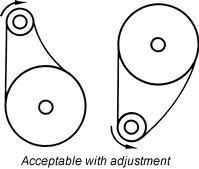Have a Question? Need Help?
Call 704-394-0322 or Email
Minimizing Cost
It is usually more economical to purchase “stock” sizes of chain and sprockets rather than ordering non-stock or made to order sizes. This is often true, even when it is necessary to buy stock components that are somewhat larger than required.
Minimizing Noise and vibration
Use smaller pitch chains and sprockets with larger numbers of teeth to reduce noise and vibration.
Sprockets
Increasing the number of teeth in sprockets will decrease noise and prolong sprocket life. Whenever possible sprockets should have a minimum of 21 teeth.
Drive Ratios
Ratios of 12:1,or greater, are possible but above 8:1 it is usually desirable to acheive the ratio in two steps.
Shaft Center Adjustment
Whenever possible it is desirable to provide adjustable shaft centers. This allows for chains to be re-tensioned as they wear and is particulary important in drives where one shaft is located vertically above the other. Typically the amount of adjustment should equal at least 1% of the center distance.
Chain Width
The use of a wider than recommended chain will result in a more rugged drive, with reduced chain stresses, and potentially longer drive life.
Shaft Center Distance
The distance between shafts should be great enough that the chain wraps the small sprocket at least 120 degrees. Generally, center distances should not exceed 60 pitches.
Chain Length
Whenever possible chain length should be an even number of pitches. An odd number of pitches requires the use of an offset section which weakens the chain and increases cost.
Tensioning Devices
An adjustable idler sprocket can often be used to maintain chain tension on drives where the shafts are fixed. In some instances, tensioning arms or pads can be pressed against the back of a chain to maintain chain tension. Consult with the chain manufacturer before employing these devices since some two pin chains can be damaged by their use.
Drive Enclosures
Fully enclosed drives, with proper lubrication, are desirable for maximum service life and personnel safety.
Non-horizontal And Vertical Shafts
Drives that use non-horizontal shafts often work best with side guide chain and an automatic tensioner. Consult Ramsey for specific recommendations.
Drive Orientation
Chain and sprocket life can be prolonged with the correct drive orientation. In the preferred orientation a line extended between shaft centers is horizontal or inclined less than 45 degrees, and the slack strand is on the bottom. Where adjustment allows excessive chain slack to be removed it may also be acceptable for the slack strand to be on the top.
 If one shaft must be located vertically above the other(a “vertical” drive) it is especially important that chains be re-tensioned as they wear. Less care and adjustment will be required if the drive can be positioned slightly off the vertical.
If one shaft must be located vertically above the other(a “vertical” drive) it is especially important that chains be re-tensioned as they wear. Less care and adjustment will be required if the drive can be positioned slightly off the vertical.
 Drives with long center distances or large ratios should generally be designed with the slack strand on the bottom.
Drives with long center distances or large ratios should generally be designed with the slack strand on the bottom.





